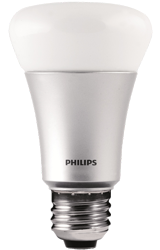The Philips Hue dimmer switches have arrived. We ordered two of the Wireless Dimming Kits, rather than just the switches themselves, as it was the equivalent of knocking off £5 the price of each bulb.
The first thing we noticed was that the bulbs included in the Dimming Kits are different to the bulbs included in the White Starter Kits. In both cases they are dimmable white LED bulbs, and Philips claim both are the A19/A60 shape, but to my mind the Starter Kit bulbs are closer to a K shape.
As it happens both bulbs fit fine, but I'm intrigued why Philips are producing two different shaped bulbs.
The bulbs in the Wireless Dimming Kits come pre-paired with the dimmer switches themselves. So you could install them without even needing a Bridge. That would make a nice and relatively cheap way into smart lighting, although you wouldn't have the network connectivity until you introduced them to a Bridge.
Pairing the bulbs and switches with the Bridge was also straightforward. The key is to add the switches first. In the mobile app this is via Settings -> My devices, and you'll need to poke the actual switch itself with a pin to get it into pairing mode (orange flashing light). I found that the Bridge couldn't automatically find the two new bulbs, so noted down their serial numbers and used the manual search facility of the mobile app, which worked fine.
To change the link between the switches and the lights or scenes that we wanted to control is configured through the My Devices settings, rather than the lights or scene settings. Our bedside lamp, which has an automatic timer to come on in the morning, now also has a dimmer switch linked to it, so we can turn the lamp off, go back to sleep and be late for work, all without having to find the tablet.
A nice touch with the dimmer switches are the holders. These come with double-sided tape, so can easily be attached to the wall or other surface (you can drill and screw if you to as well). The actual dimmer switches themselves are magnetically attached to the holders. So you can detach the switch and carry it around to wherever you are. In the lounge for example we take the switch from the wall, and when it is movie time we can be extremely lazy and dim the lights without having to get up off of the sofa. There is the risk of the switch disappearing forever down the back of the sofa, but then there's always the mobile app for backup!
The first thing we noticed was that the bulbs included in the Dimming Kits are different to the bulbs included in the White Starter Kits. In both cases they are dimmable white LED bulbs, and Philips claim both are the A19/A60 shape, but to my mind the Starter Kit bulbs are closer to a K shape.
 |
| White Starter Kit bulb |
 |
| Wireless Dimming Kit bulb |
As it happens both bulbs fit fine, but I'm intrigued why Philips are producing two different shaped bulbs.
The bulbs in the Wireless Dimming Kits come pre-paired with the dimmer switches themselves. So you could install them without even needing a Bridge. That would make a nice and relatively cheap way into smart lighting, although you wouldn't have the network connectivity until you introduced them to a Bridge.
Pairing the bulbs and switches with the Bridge was also straightforward. The key is to add the switches first. In the mobile app this is via Settings -> My devices, and you'll need to poke the actual switch itself with a pin to get it into pairing mode (orange flashing light). I found that the Bridge couldn't automatically find the two new bulbs, so noted down their serial numbers and used the manual search facility of the mobile app, which worked fine.
To change the link between the switches and the lights or scenes that we wanted to control is configured through the My Devices settings, rather than the lights or scene settings. Our bedside lamp, which has an automatic timer to come on in the morning, now also has a dimmer switch linked to it, so we can turn the lamp off, go back to sleep and be late for work, all without having to find the tablet.
A nice touch with the dimmer switches are the holders. These come with double-sided tape, so can easily be attached to the wall or other surface (you can drill and screw if you to as well). The actual dimmer switches themselves are magnetically attached to the holders. So you can detach the switch and carry it around to wherever you are. In the lounge for example we take the switch from the wall, and when it is movie time we can be extremely lazy and dim the lights without having to get up off of the sofa. There is the risk of the switch disappearing forever down the back of the sofa, but then there's always the mobile app for backup!









